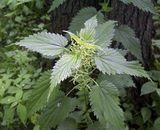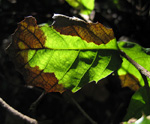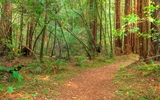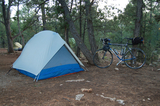Make sure your visit to San Mateo County Parks is a fun and safe one by preparing yourself. Bring a cell phone to use in case you need help (also recognize that not all park areas have cell phone reception). Check the weather ahead of time and make sure you wear the right clothes. If you're going to hike, get an idea of your route ahead of time by consulting the trails section of this web site, or the maps in park brochures. Bring footwear to match the terrain.
Keep in mind that you are a guest of the many plants and animals that call San Mateo County Parks their home. Remember the golden rule: Leave the plants and animals alone and they will leave you alone. Below are some natural features found in our parks. Educate yourself and take the necessary steps to avoid danger to yourself or our local wildlife. If you have an emergency, call 9-1-1 for assistance.
Animal Life

Mountain Lions hunt alone at night, but can be present anytime. They weigh up to 150 pounds, have yellowish brown fur, and a dark-tipped tail that may be two to three feet long. Mountain lions hunt larger animals such as deer, elk and big horn sheep, dependent on the geographical area. Though sightings are rare, mountain lions may be encountered at any of the following parks: Devil's Slide Trail, San Pedro Valley, San Bruno Mountain, Junipero Serra, Quarry/Wicklow, Crystal Springs Regional Trail, Edgewood, Huddart, Wunderlich, Memorial, Pescadero Creek, and Sam McDonald. Educate yourself about how to avoid mountain lions and what to do if you see one:
- Do not hike during times of day that wildlife hunts, early morning and dusk.
- Hike or jog with someone else.
- If you encounter a mountain lion shout and wave your arms or your coat. The objective is to make yourself look as large and imposing as possible.
- Maintain eye contact with the wild cat; do not crouch down.
- Throw any sticks and stones you can reach without bending down.
- Pick up small children or pets and keep them from panicking and running.
- Report any mountain lion you see to park rangers with the location, date and time of the sighting.
- If attacked, FIGHT BACK! Try to remain standing and face the attacking animal.
- Report dangerous behavior to the California Department of Fish & Wildlife.
Learn more about protecting and living beside mountain lions at the California Department of Fish & Wildlife's Website. Also see a map of bay area mountain lion sightings at the Bay Area Puma Project.

Bobcats hunt alone at night, but can be present anytime. They are more commonly sighted than mountain lions. Bobcats are smaller than mountain lions, weighing up to 60 pounds, and have spotted orange fur, a short tail, and blacked-tipped ears. They hunt small creatures such as squirrels and rabbits. Generally they aren't dangerous to humans, but protect your pets. If you encounter a bobcat:
- Shout and wave your arms or your coat. The objective is to make yourself look as large and imposing as possible.
- Maintain eye contact with the wild cat, and do not crouch down.
- Pick up small children or pets and keep them from panicking and running.

Coyotes play an integral role in their ecosystems by regulating the rodent population, which comprises 90% of their diet. They are primarily pack animals but can be seen hunting alone.
Coyotes usually avoid people whenever possible. Aggressive behavior towards humans is unusual and is most often the result of habituation due to feeding by humans. If you encounter a coyote remember the following:
- Never feed or attempt to tame a coyote.
- Avoid direct eye contact.
- Don't turn your back or run from the coyote.
- Attempt to leave the area calmly.
- If followed by a coyote, make loud noises and make yourself look big. If this fails, throw rocks.
- Always keep yourself between the coyote and small children or pets.
- If attacked, fight back.
- Coyotes aren't considered a disease threat. Outbreaks of rabies are rare and not commonly implicated in the transmission of the disease to humans or domestic animals.
- Report dangerous behavior to the California Department of Fish & Wildlife.

Raccoons are 23 to 41 inches in length with grayish-brown fur. Their body tends to be heavily built weighing up to 40 lb. The face has a distinguishing black mask and the tail usually has about six black rings encircling the tail. Raccoons, like squirrels, skunks, and foxes are scavengers and are often seen around campgrounds, foraging through garbage cans. They like to feed on food left out by park visitors. Although they seem calm, these animals are wild and may bite or claw you. Raccoons may carry diseases such as rabies. If you encounter a raccoon:
- Do not touch or pick up the raccoon.
- Do not feed the raccoon.
- Move away from the raccoon so that it can run away.

Rattlesnakes are common throughout the park system and are important members of the natural community. Helping to keep the rodent population under control, they feed on small rodents, rabbits, birds, and almost anything alive that can be swallowed. Rattlesnakes are venomous snakes with movable front fangs and typically have a rattle at the end of their tail. The rattle sound is a warning by the snake which it uses to make its presence known. They will not attack, but if disturbed or cornered, they will defend themselves. Rattlesnakes are found around rocks and are usually out when the weather is warm. If you encounter a rattle snake:
- Do not pick up the snake.
- Do not disturb or corner the snake.
- Move away and the snake will flee most of the time.

Wild pigs are introduced members of the natural habitat and are commonly seen in the park system. They can become a nuisance disturbing camping, picnic, and natural areas. Pigs can be dangerous and aggressive when cornered or when tempted by food. Wild animals that become aggressive may have to be destroyed. If you encounter a pig:
- Do not approach a wild pig.
- Back away slowly, giving the pig an opportunity to escape.
- Pigs have poor eye sight, so wave your arms side to side, make noise, and speak loudly in a non-threatening manner.
Insect Life

Ticks are parasites that feed on the blood of their host by anchoring into the skin using hook-like mouthparts. Ticks don't fly like bees, jump like fleas, or drop from trees like spiders. Instead, they climb vegetation, rocks, and logs and wait for an animal or a human to brush up against them. Avoid tick bites by taking proper precautions:
Wear light-colored long pants and long sleeved shirts, socks, and shoes. The light colored clothes help you to see the ticks.
Use a repellent registered with the Environmental Protection Agency (EPA) for use against ticks (such as >20% DEET). Always follow directions on the container and be extra careful when applying to children.
If possible, wear clothing that has been treated with the insecticide permanone (or permethrin). This insecticide on fabric will kill ticks even after many washings.
Stay in the middle of the trail. Avoid trail margins, brushy and grassy areas, leaf-litter, and downed wood or wood products in forested areas where ticks are found.
Check yourself often for ticks while recreating or working in places where ticks may live, such as in wilderness areas, parks, or gardens. Afterwards, thoroughly check your entire body for ticks for several days. Parents should examine their children, especially on the scalp, hairline, and in the belly button after activities in tick-infested areas.
Shower within a few hours after leaving areas where ticks are found and remove any ticks you find on you.
If you are bitten by a tick make sure to remove the tick as soon as possible. Use tweezers or your fingers to grab the tick close to your skin and pull the tick firmly, straight out (do not jerk, twist or burn the tick).Wash your hands and the bite site with soap and water after the tick is removed and apply an antiseptic to the bite site.
Ticks can carry many diseases transmittable to humans such as:
Taking proper precautions to avoid tick bites is the best protection against tick-borne diseases. Persons who do experience a tick bite should be alert for up to 30 days to symptoms such as fever, rash, redness, swelling, and infection-like or flu-like symptoms. Should these or any other symptoms of concern develop, contact a physician.
Learn More:

Yellowjackets are the common name for several different species of wasps indigenous to the state of California. Some species found at county parks are considered pests, favoring picnic areas, garbage cans and refreshment stands. Yellowjackets live in colonies ruled by a single queen. They sometimes attach their nests to trees, shrubs, or buildings though native pest species tend to construct their nests underground. Yellowjackets are attracted to sweet foods such as honey, candy, fruits, and soft drinks. In addition, the common pest species collect around red meats, chicken and fish. Yellowjackets can defend themselves by delivering a painful sting which may cause swelling and itching. Certain people allergic to yellowjackets can encounter serious medical complications from a single sting. If you are stung by a yellowjacket:
- Remove the stinger, if left in your skin, by scraping from the side with your fingernail.
- Apply cold water or ice in a wet cloth.
- Lie down if you feel faint or dizzy.
- Lower the stung arm or leg.
- Do not consume alcohol.
- If allergic to yellowjacket venom seek medical attention immediately.
Poisonous & Stinging Plants

Poison Oak (Toxicodendron diversilobum) is common throughout the park system. It can grow as a shrub or as a vine which scales trees. It is recognizable by a grouping of three leaves which range in color from green, to yellow, to red. When Poison Oak is contacted its oil may cause an irritating rash. Pets running loose around poison oak may get the oil on their fur and later pass it on to their owners. If you come into contact with poison oak:
- Wash your skin with soap and warm water as soon as possible (The oil typically penetrates the skin within ten minutes). Scrub under fingernails with a brush to avoid spreading oil to other parts of the body.
- Reactions range from very mild to very severe, sometimes requiring emergency care at the hospital.
- If rash develops, calamine lotion may be used on the skin to decrease itching. This, as well as other ointments and creams, can be found at your local drug store. Rashes usually last for a week or two.
- Call your physician if the rash/itching is severe or does not stop.

Stinging Nettle (Urtica dioica) grows in moist, shady places throughout the park system. Its bright green leaves and stems are covered with hollow hairs which come off easily when the plant is brushed. These hairs are filled with formic acid, the same acid ants have in their saliva glands, which causes an instant painful stinging sensation. Also, as the skin reacts, a rash forms lasting about a day. If you come in contact with stinging nettle:
- Stinging nettle acid can be neutralized by applying a paste of baking soda (made by adding a little water). Apply to the infected area immediately.
- Human saliva may help when rubbed into the itchy area if baking soda is not handy.
- A local plant, the Curled Dock Rumex Crispus, grows in the same habitat as stinging nettle and can help when crushed and rubbed on the itchy area.

Death Cap Mushrooms (Amanita phalloides) are deadly wild mushrooms that pop up in San Mateo County Parks, often after rain. Please note that San Mateo County Ordinance 3.68.080(a) protects all vegetative resources in County Parks including mushrooms. Mushroom collecting and eating is not allowed.
If you are mushroom hunting outside our parks, don't eat any mushrooms you collect unless you are absolutely sure of identification. When in doubt, throw it out! Dogs are at risk as well.
Anyone who has eaten a wild mushroom and is experiencing abdominal pain, cramping, vomiting, and diarrhea should seek medical attention immediately and call California Poison Control at 1-800-222-1222. See the North American Mycological Association resources on poisonings and mushroom ID.
Sudden Oak Death

Sudden Oak Death is a disease caused by the Phytophthora ramorum plant pathogen, which attacks oak and other tree species causing bleeding cankers on the trunk, dead foliage, and in many cases the death of the tree. The pathogen spreads itself during the rainy season when plant leaves, organic material and soil, which may harbor spores, are more likely to stick to clothes, pets, vehicles, equipment, etc.
You can help contain the disease by doing the following:
- Avoid entering infested areas during wet conditions.
- Don’t collect or transport host plant material from an infested or quarantined area.
- Keep vehicles on paved and graveled surfaces when conditions are wet.
- If you do enter an infested area during wet conditions, check yourself, your pet(s), vehicle and equipment for accumulations of mud, soil, organic material, and detached plant leaves. Remove these accumulations before traveling to an area that is not infested.
- If you live in an infested area, chances are some of your belongings may be contaminated by the pathogen. If you travel to an area that does not have the disease, be sure that the belongings that you take with you are clean – shoes, bicycles, pets, vehicle, etc.
Safety on Coastal Bluffs

When visiting coastal bluff areas, especially during periods of heavy rain or surf conditions, please use extreme caution and avoid walking near or around the bluff edge. There can be areas that appear to be stable, but may not be. For this reason, we advise hikers to stay on designated trails. Maps showing designated trails are posted at Park entrances and on our website. For the safety of your dog and to prevent further erosion of sensitive areas, please follow the County ordinance that requires dogs to be on leash at all times when visiting locations that allow dogs.
General Trail Safety

Guidelines
- Stay on designated trails.
- Keep children close to you at all times.
- Avoid hiking alone.
- Make noise while you hike so as not to surprise any of the animal life mentioned above.
- When encountering wildlife back away slowly, giving wildlife an opportunity to escape.
- Never harass, chase, or corner any wild animal.
- Report any unusual animal behavior to park staff.
- Please follow park regulations.
General Food Safety

To protect yourself, your family, and friends from foodborne illness during warm-weather months, inform yourself on how to handle food safely when eating out doors. Read the FDA's simple food safety guidelines for transporting your food to the picnic site, and for preparing and serving it safely once you've arrived.
General Campground Safety

Guidelines
- Do not feed or leave food for any wild animal.
- Store food & ice chests in a car or food locker.
- Maintain a clean area and place trash in garbage cans.